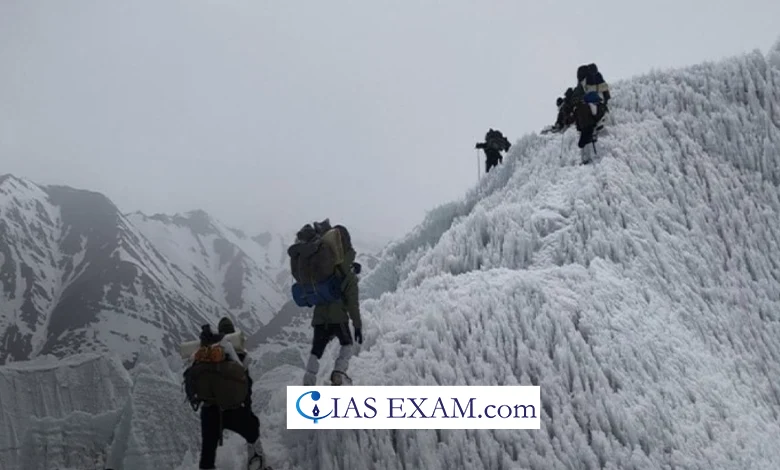
Context
Operation Meghdoot is a significant chapter in India’s military history, marking its strategic dominance over the Siachen Glacier. Launched on April 13, 1984, this operation has completed 40 years, symbolising India’s resilience and tactical prowess.
Operation Meghdoot: The Preemptive Strike
- In the early 1980s, Pakistan began allowing foreign mountaineering expeditions to Siachen, subtly asserting its claim.
- India, receiving intelligence about Pakistan’s imminent military action, launched Operation Meghdoot.
- The operation’s success was significantly aided by reconnaissance missions led by Col. Narinder ‘Bull’ Kumar, providing vital information for the planning process.
Genesis of the Conflict
- The conflict over Siachen stems from the ambiguous delineation of the Line of Control (LoC) post the 1972 Simla agreement.
- While the LoC was accepted up to point NJ-9842, the glacier remained unmarked.
- India’s stance is based on historical agreements that extend the LoC “Northwards to the glaciers,” while Pakistan interprets it as “North-Eastwards,” claiming the area beyond the Saltoro Ridge.
Operation’s Execution
- On April 13th, 1984, Indian troops, under the leadership of then Captain Sanjay Kulkarni reached the top of the Siachen Glacier and positioned themselves at the peak of the Saltoro Ridge.
- In this way, the Indian authorities were able to hit their rivals with a double whammy; they struck fast and forcefully, with the result of the whole Gulf region coming under their control significantly.
Human Cost
- Despite the ceasefire, the operation continues, with the harsh climate being the fiercest enemy.
- Approximately 1,150 soldiers have lost their lives, primarily due to the extreme weather conditions.
Land of Roses
- Ironically, Siachen, in the Balti language, means “land of roses” — a stark contrast to its reputation as a cold and desolate battlefield.
- The glacier sits at an altitude of 15,632 feet, with temperatures plummeting to -50°C.
Cost of Vigilance
- The downside of military presence at Siachen is that it consumes a disproportionate amount of men and material.
- Indian army’s commitment for the security of the northern Ladakh region and the lifeline highway Leh-Srid nehra.
Geopolitical Significance
- Strategic Location: Siachen Glacier is at the northernmost apex of India, next to the territory boundaries of Pakistan and China. The position holds a high value due to it being at a strategic location from where India can ensure both the close monitoring of military and the security of its northern frontiers.
- Historical Context: It was a move of preemptive defence to keep Pakistan away from claiming the glacier.Following Kashmir delineation in 1972 Simla Agreement that was ambiguous, the area around Siachen had no line of demarcation by two countries which renders the status of the region controversial.
- Military Advantage: Now that the vantage of Saltoro Ridge is secured to it, India, in particular, has obtained many advantages, such as the possibility of the surveillance of the region and control over glacier access. By this action the Anglo-Tibetan-Nepalese-Indian alliance decided to cut an open sore to Pakistani prestige of power in the region.
- Environmental and Economic Aspects: The glacier is a major freshwater reservoir and therefore has got prospects of the economic dimension. India, through having its control over Siachen, prevents closure of this access and also denies any of its neighbouring countries chances to unilaterally take advantage of these resources.
- National Security: The Operation Meghdoot signifies the triumph of India which is ready to defend its independence and integrity of its territory. The accomplishment with reference to the operation delivers a finishing blow to the intent of armed conflict and increases India’s reputation in the diplomatic intervention.
- Modern Relevance: Even as of today, the chief contribution of the Op is still germane not only to the Indian policies but also to the consolidative role; it helps India in building relationships with its two powerful neighbours; Pakistan and China. Continuously, the Siachen Glacier as a key piece in the geopolitical puzzle of South Asia the issue arises.
Conclusion
Operation Meghdoot stands as a testament to the Indian military‘s strategic foresight and the soldiers’ valour. As the operation marks its 40th anniversary, it continues to be a symbol of India’s commitment to safeguarding its territorial integrity against all odds. The operation’s legacy will be remembered for its demonstration of India’s capability to conduct successful high-altitude warfare, setting a precedent for future military operations in similar terrains.
Source: The Hindu
UPSC Prelims Practice Question
Q.Operation Meghdoot refers to:
a) India’s military operation in the Siachen Glacier region.
b) Pakistan’s military operation in the Kargil region.
c) Nepal’s military operation in the Everest region.
d) China’s military operation in the Aksai Chin region.
Ans- a





.png)



